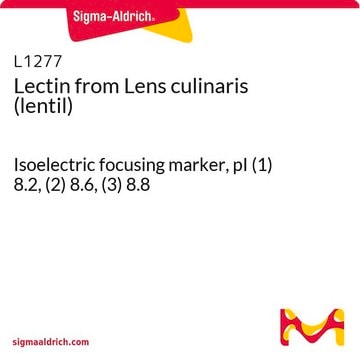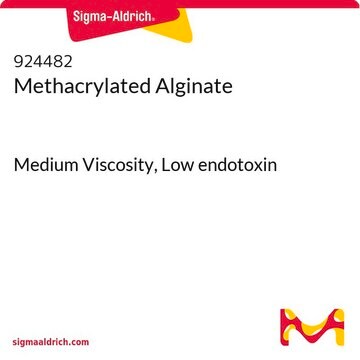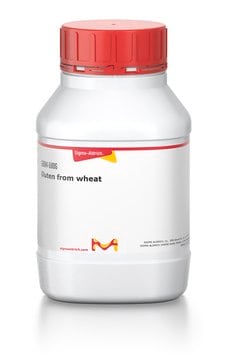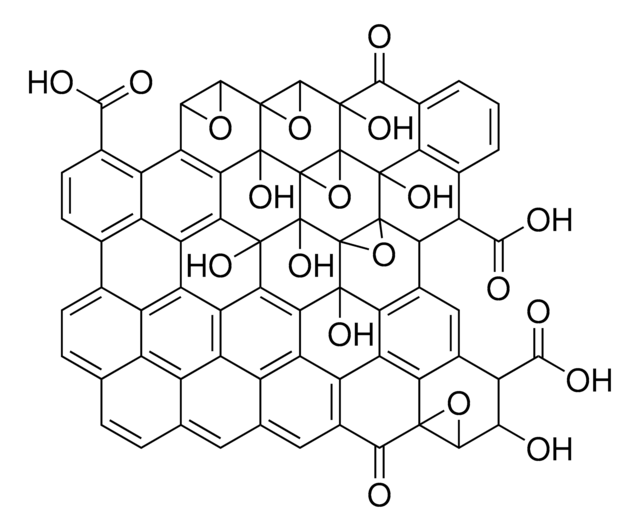추천 제품
일반 설명
Gelatin is a natural biopolymer derived from collagen that plays an important role in the biomedical field due to its biocompatibility, biodegradability, and nonimmunogenicity. Acrylate-functionalized gelatin, or gelatin acrylate, can be crosslinked using thiol-Michael click chemistry as well as photochemical crosslinking. It′s properties are very similar to gelatin methacrylate (GelMA). Crosslinked gelatin hydrogels have many applications in tissue engineering and 3D bioprinting.
애플리케이션
- Endothelial cell morphogenesis
- Injectable tissue constructs
- Tissue engineering of multiple tissue types including heart tissue (cardiomyocytes), bone tissue (osteogenesis), cartilage tissue (chondrogenesis), and epidermal tissue
- Drug delivery applications including contact lens and dental
특징 및 장점
- Photopolymerizable
- Clickable
- Biocompatible
- Biodegradable
관련 제품
제품 번호
설명
가격
Storage Class Code
11 - Combustible Solids
WGK
WGK 1
Flash Point (°F)
Not applicable
Flash Point (°C)
Not applicable
시험 성적서(COA)
제품의 로트/배치 번호를 입력하여 시험 성적서(COA)을 검색하십시오. 로트 및 배치 번호는 제품 라벨에 있는 ‘로트’ 또는 ‘배치’라는 용어 뒤에서 찾을 수 있습니다.
Hongyuan Zhu et al.
Journal of the mechanical behavior of biomedical materials, 88, 160-169 (2018-09-03)
Biocompatible hydrogels with defined mechanical properties are critical to tissue engineering and regenerative medicine. Thiol-acrylate photopolymerized hydrogels have attracted special interest for their degradability and cytocompatibility, and for their tunable mechanical properties through controlling factors that affect reaction kinetics (e.g.
Xin Zhao et al.
Advanced healthcare materials, 5(1), 108-118 (2015-04-17)
Natural hydrogels are promising scaffolds to engineer epidermis. Currently, natural hydrogels used to support epidermal regeneration are mainly collagen- or gelatin-based, which mimic the natural dermal extracellular matrix but often suffer from insufficient and uncontrollable mechanical and degradation properties. In
Chaenyung Cha et al.
Biomacromolecules, 15(1), 283-290 (2013-12-19)
Microfabrication technology provides a highly versatile platform for engineering hydrogels used in biomedical applications with high-resolution control and injectability. Herein, we present a strategy of microfluidics-assisted fabrication photo-cross-linkable gelatin microgels, coupled with providing protective silica hydrogel layer on the microgel
Kelly M C Tsang et al.
Advanced functional materials, 25(6), 977-986 (2015-09-04)
Hydrogels are often employed as temporary platforms for cell proliferation and tissue organization in vitro. Researchers have incorporated photodegradable moieties into synthetic polymeric hydrogels as a means of achieving spatiotemporal control over material properties. In this study protein-based photodegradable hydrogels
Aleksander Skardal et al.
Tissue engineering. Part A, 16(8), 2675-2685 (2010-04-15)
Bioprinting by the codeposition of cells and biomaterials is constrained by the availability of printable materials. Herein we describe a novel macromonomer, a new two-step photocrosslinking strategy, and the use of a simple rapid prototyping system to print a proof-of-concept
자사의 과학자팀은 생명 과학, 재료 과학, 화학 합성, 크로마토그래피, 분석 및 기타 많은 영역을 포함한 모든 과학 분야에 경험이 있습니다..
고객지원팀으로 연락바랍니다.








